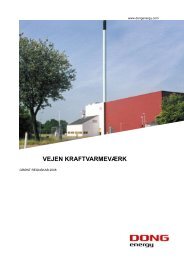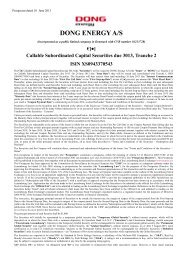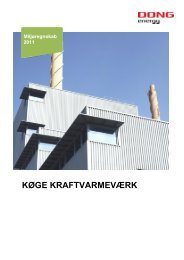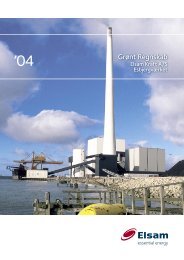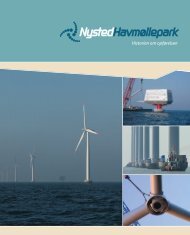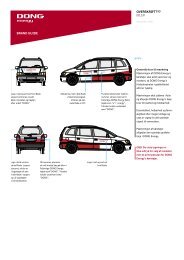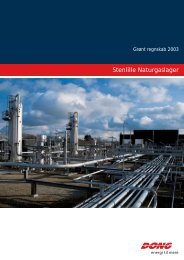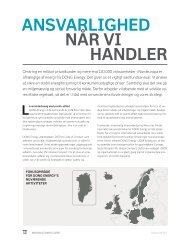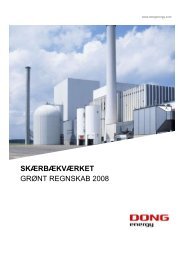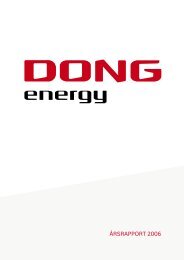ANNUAL REPORT 2011 - DONG Energy
ANNUAL REPORT 2011 - DONG Energy
ANNUAL REPORT 2011 - DONG Energy
Create successful ePaper yourself
Turn your PDF publications into a flip-book with our unique Google optimized e-Paper software.
notes<br />
40 Description of accounting policies<br />
Depreciation periods for property, plant and equipment<br />
Buildings used for own purposes1 20 - 50 years<br />
Production assets, natural gas and oil2 20 - 40 years<br />
Production assets (thermal), electricity 20 - 35 years<br />
Production assets, district heat 25 - 35 years<br />
Wind turbines3 20 - 24 years<br />
Geothermal plants 20 years<br />
Distribution networks, natural gas3 20 - 40 years<br />
Distribution networks, electricity 10 - 40 years<br />
Distribution networks, heat 10 - 50 years<br />
Natural gas storage facilities3 Gas transportation system (marine<br />
20 - 40 years<br />
pipelines) 3 20 - 40 years<br />
Oil transportation system (marine<br />
pipeline) 15 years<br />
Exploration assets 4 -<br />
IT hardware 3 - 5 years<br />
Fixtures and fittings, tools and equipment 3 - 10 years<br />
Assets under construction4 -<br />
1 Land is not depreciated.<br />
2 Depreciation is charged applying the unit-of-production method.<br />
3 The depreciation profile takes account of the fact that the earnings<br />
profile changes substantially over the life of the asset as a result of the<br />
statutory revenue caps.<br />
Where individual components of an asset have different useful<br />
lives, they are accounted for as separate items, which are depreciated<br />
separately.<br />
The basis of depreciation is determined on the basis of the asset’s<br />
residual value less any impairment losses. The residual<br />
value is determined at the acquisition date and reassessed<br />
annually. Depreciation ceases if the residual value exceeds the<br />
carrying amount of the individual components.<br />
If the depreciation period or the residual value changes, the effect<br />
on depreciation is recognised prospectively as a change in<br />
accounting estimates.<br />
Prepayments for property, plant and equipment are classified<br />
together with property, plant and equipment under<br />
construction.<br />
impairment of assets<br />
Goodwill and intangible assets with an indefinite useful life are<br />
tested for impairment annually, initially before the end of the<br />
year of acquisition. In-process development projects are also<br />
tested annually for impairment.<br />
132 COnsOliDatED finanCial statEmEnts – <strong>DONG</strong> ENERGY <strong>ANNUAL</strong> <strong>REPORT</strong> <strong>2011</strong><br />
The carrying amount of goodwill is tested for impairment, along<br />
with the carrying amounts of the other non-current assets of the<br />
cash-generating unit to which the goodwill has been allocated,<br />
and written down to the recoverable amount via profit for the<br />
year if the carrying amount exceeds the recoverable amount.<br />
Exploration assets are tested for impairment if there is any<br />
indication of impairment. In carrying out the test, emphasis<br />
is placed on the special indicators that are relevant to the<br />
exploration industry, including the duration of the period for<br />
which <strong>DONG</strong> <strong>Energy</strong> holds the rights for exploration wells, the<br />
timing and costs in connection with the exploration wells in the<br />
individual fields, the results of existing exploration wells and<br />
the expectations concerning future exploration wells, including<br />
the level of future exploration wells, and the probability that the<br />
exploration wells will result in commercial finds. The recoverable<br />
amount of exploration assets is reviewed if any indication<br />
of impairment exists. The recoverable amount is the higher of<br />
an asset’s fair value less expected disposal costs and its value<br />
in use. Value in use is determined as the present value of the<br />
expected future cash flows from the asset or cash-generating<br />
unit to which the asset belongs.<br />
Deferred tax assets are reviewed annually and recognised to<br />
the extent that it is probable that they will be utilised.<br />
The carrying amounts of other non-current assets are tested<br />
annually to determine if any indication of impairment exists. If<br />
any such indication exists, the asset’s recoverable amount is<br />
determined. The recoverable amount is the higher of an asset’s<br />
fair value less expected disposal costs and its value in use.<br />
An impairment loss is recognised whenever the carrying<br />
amount of an asset or its cash-generating unit exceeds its<br />
recoverable amount. Impairment losses are recognised in profit<br />
for the year as depreciation, amortisation and impairment<br />
losses on intangible assets and property, plant and equipment.<br />
Impairment losses relating to goodwill are not reversed.<br />
Impairment losses relating to other assets are reversed to the<br />
extent that the assumptions or estimates that led to the impairment<br />
have changed. Impairment losses are only reversed<br />
to the extent that the asset’s new carrying amount does not<br />
exceed the value of the asset after depreciation had no impairment<br />
losses been charged.<br />
Equity<br />
Hedging reserve<br />
The hedging reserve comprises the accumulated net change<br />
in the fair value of hedging transactions that qualify for designation<br />
as hedges of future cash flows, and where the hedged<br />
transaction has yet to be realised, less the related tax.



